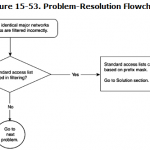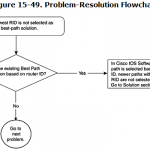Understanding Enhanced Interior Gateway Routing Protocol (EIGRP) Metrics EIGRP and IGRP use the same equation to calculate their metrics; however, the EIGRP metric is obtained by multiplying the IGRP metric by 256. In other words: where the IGRP metric is shown in Equation 6-1. By default, the K values of K1 and K3 are 0; therefore, the EIGRP metric simplifies to … [Read more...]
Understanding Open Shortest Path First (OSPF)
Understanding Open Shortest Path First (OSPF) OSPF Packet Details OSPF has five types of packets used for various reasons. Table 8-1 documents the different OSPF packet types and describes their functionality. All the OSPF packet types share a common 20-byte OSPF protocol header. Figure 8-1 shows the common OSPF protocol header format. The list that follows … [Read more...]
Troubleshooting BGP Filtering
Troubleshooting BGP Filtering BGP offers a powerful filtering mechanism when advertising or receiving BGP routes. Filtering rules are defined based on the BGP peering relationship. An ISP might want to exchange full BGP routes to another ISP but might want to give only partial routes to its enterprise customer. On the other hand, an enterprise customer might want to advertise … [Read more...]
Troubleshooting BGP Best-Path Calculation Issues
Troubleshooting BGP Best-Path Calculation Issues Chapter 14 discusses in detail how the BGP best-path algorithm works to select a single best route out of many to install in the IP routing table and to advertise to other BGP neighbors. This section discusses a few cases that deal with scenarios in which best-path selection does not work as intended. The following are the … [Read more...]
Troubleshooting Load-Balancing Scenarios in Small BGP Networks
Troubleshooting Load-Balancing Scenarios in Small BGP Networks Problem: Load Balancing and Managing Outbound Traffic from a Single Router When Dual Homed to Same ISP—Cause: BGP Installs Only One Best Path in the Routing Table In multihomed scenarios, a common concern that enterprise network operators face is improperly utilizing the external links going to the ISP. Typically, … [Read more...]
Troubleshooting Outbound IP Traffic Flow Issues Because of BGP Policies
Troubleshooting Outbound IP Traffic Flow Issues Because of BGP Policies BGP's real power is in managing IP traffic flows coming in and going out of the AS. BGP in general and Cisco IOS Software in particular offer a great deal of flexibility in manipulating BGP attributes LOCAL_PREFERENCE, MED, and so forth to control BGP best-path calculation. This best-path decision … [Read more...]
Troubleshooting BGP Route-Reflection Issues
Troubleshooting BGP Route-Reflection Issues Route reflectors (RR), discussed in RFCs 1966 and 2796, are used to avoid IBGP full mesh in an AS, as required by RFC 1771. Route reflection ensures that all IBGP speakers in an AS receive BGP updates from all parts of the network without having to run IBGP between all the routers in the network. Route reflection reduces the number … [Read more...]
Troubleshooting BGP Route Not Installing in Routing Table
Troubleshooting BGP Route Not Installing in Routing Table This section discusses issues related to BGP routes not getting installed in the IP routing table. If a router must forward an IP packet by looking at the IP destination address in IP packet, the router must have an IP routing table entry for the subnet of the IP destination address. If the BGP process fails to … [Read more...]
Troubleshooting BGP Route Advertisement /Origination and Receiving
Troubleshooting BGP Route Advertisement /Origination and Receiving Another common problem after neighbor relationship issues that BGP operators face occurs in BGP route advertisement/origination and receiving. BGP originates routes only by configuration. However, it needs no configuration in receiving routes. Larger ISPs originate new BGP routes for their customers on a … [Read more...]



